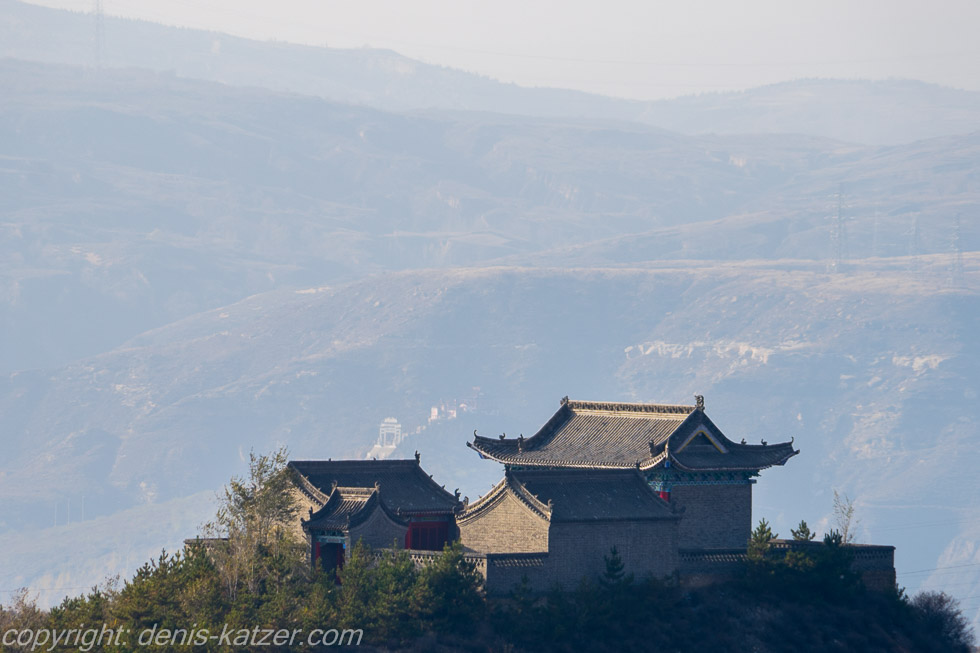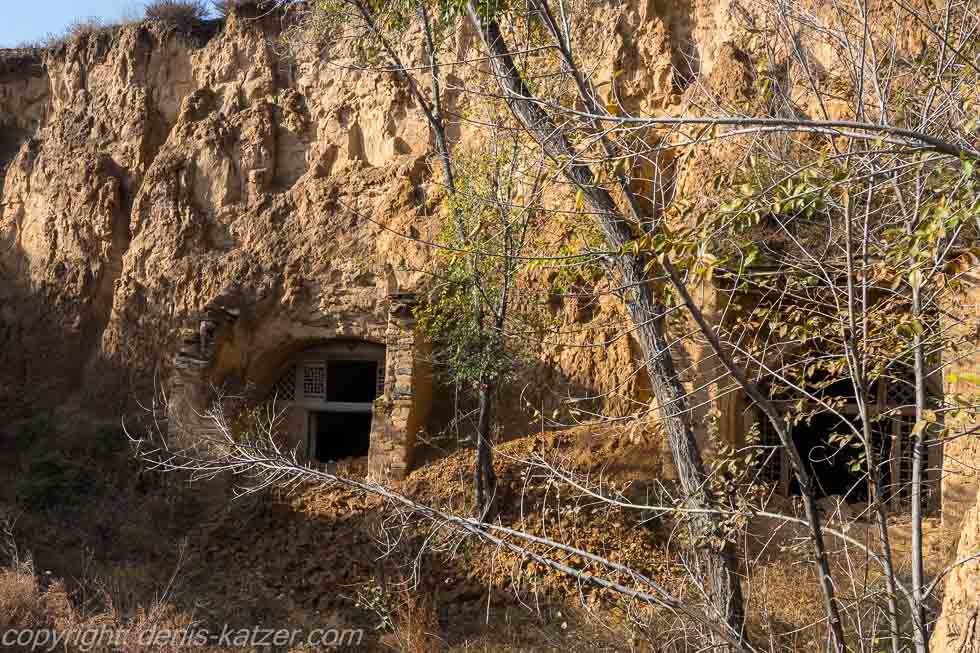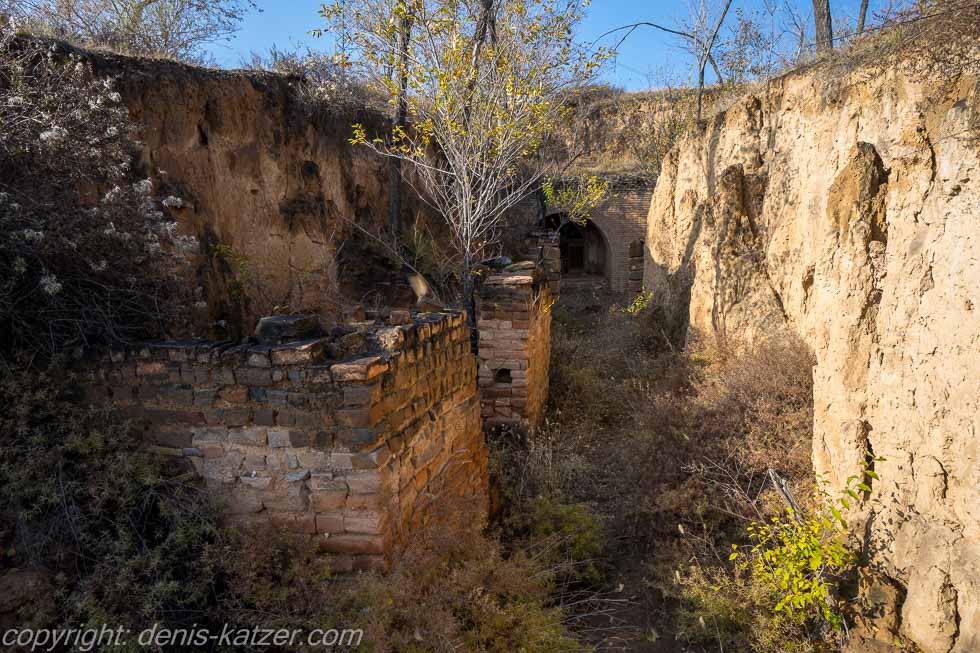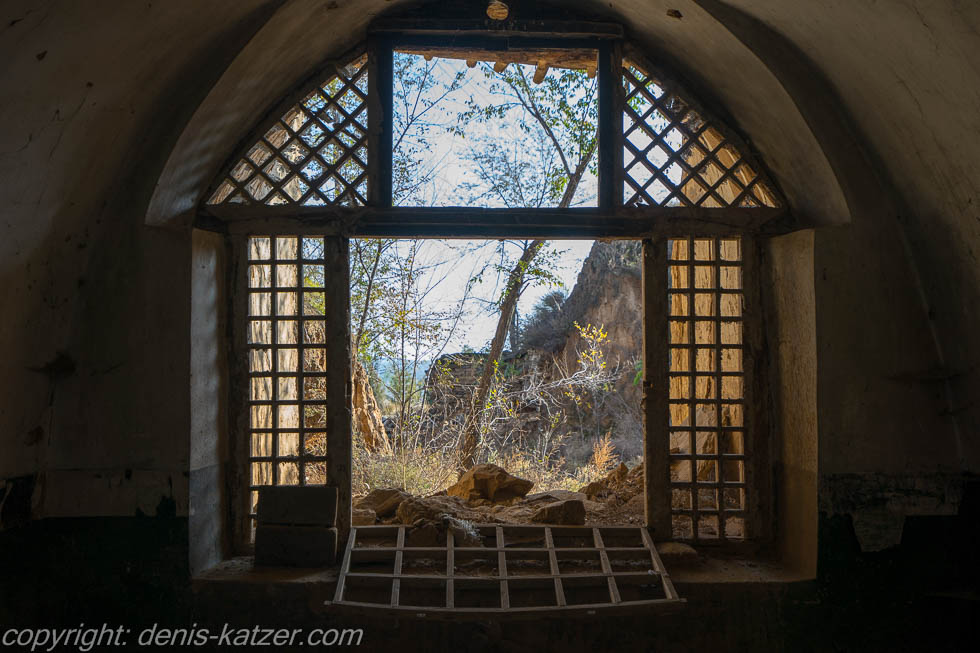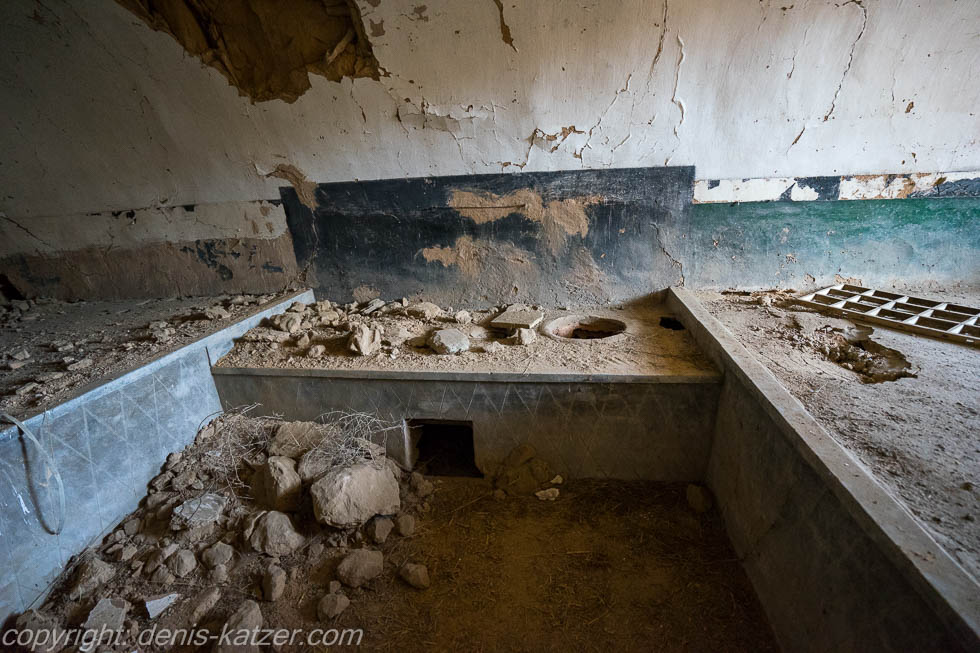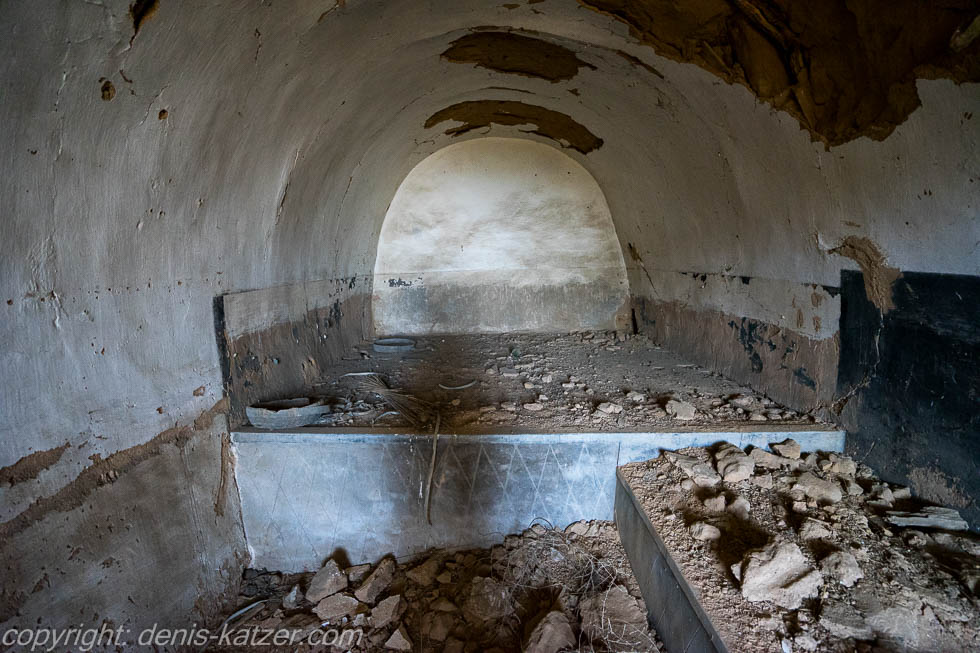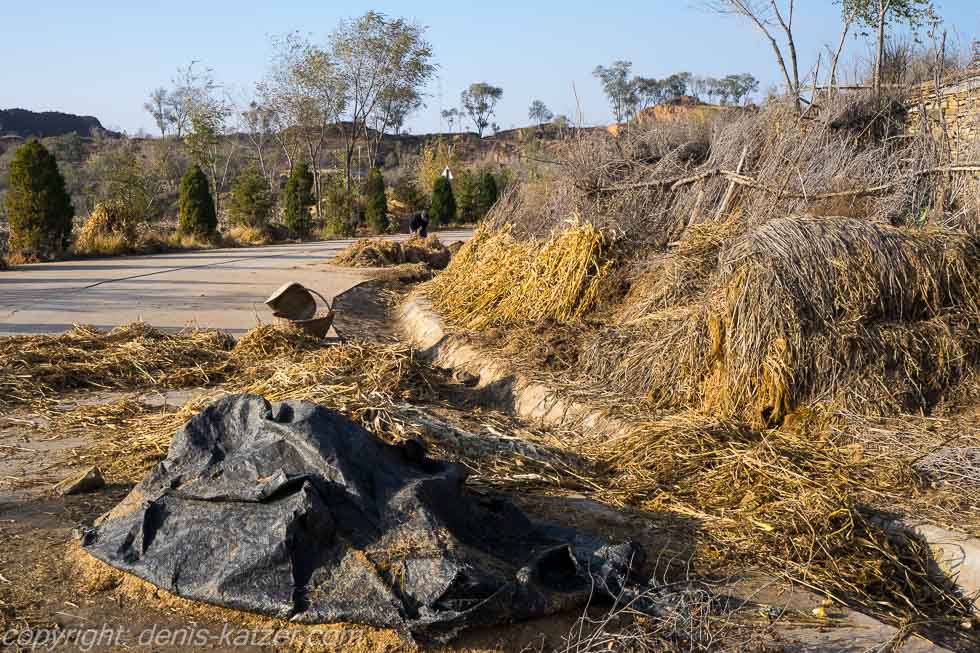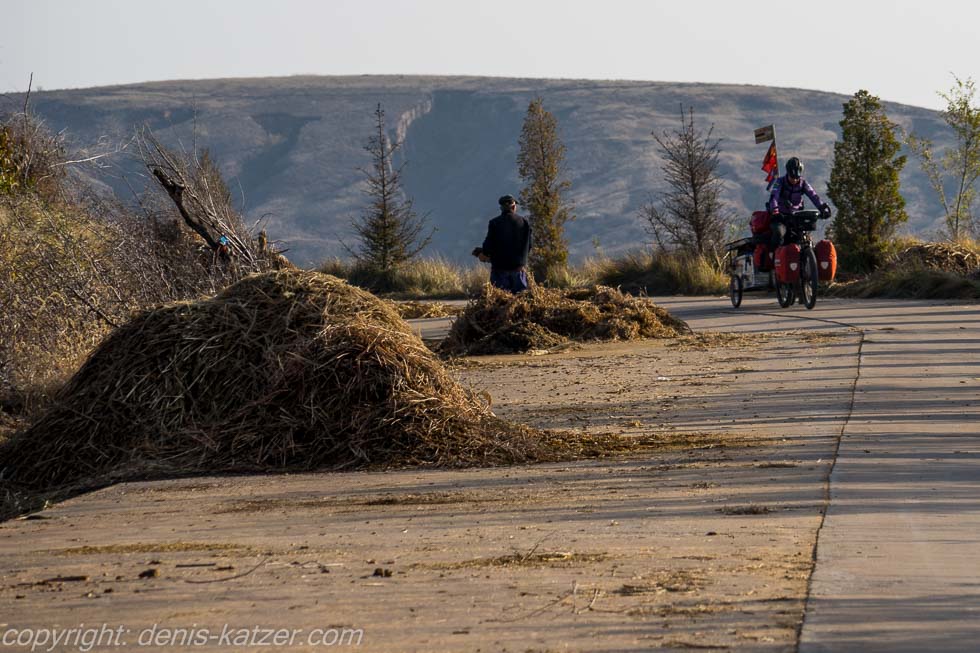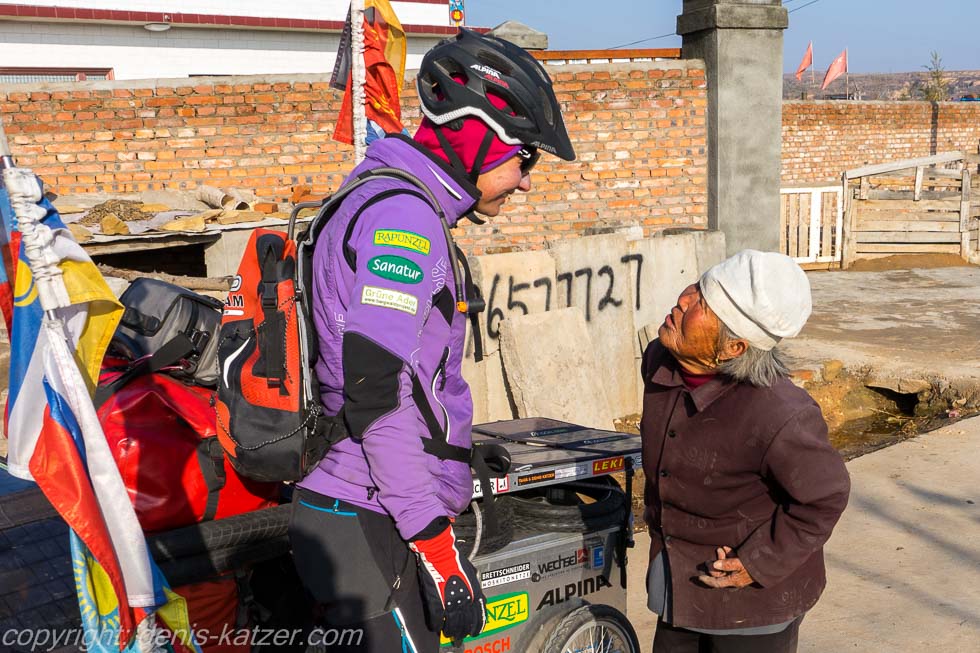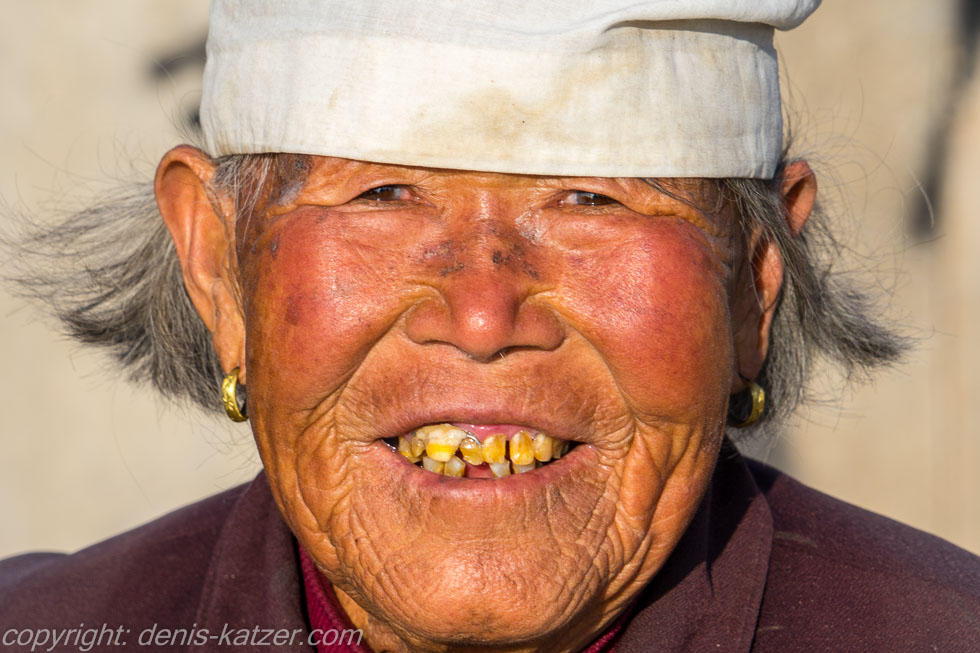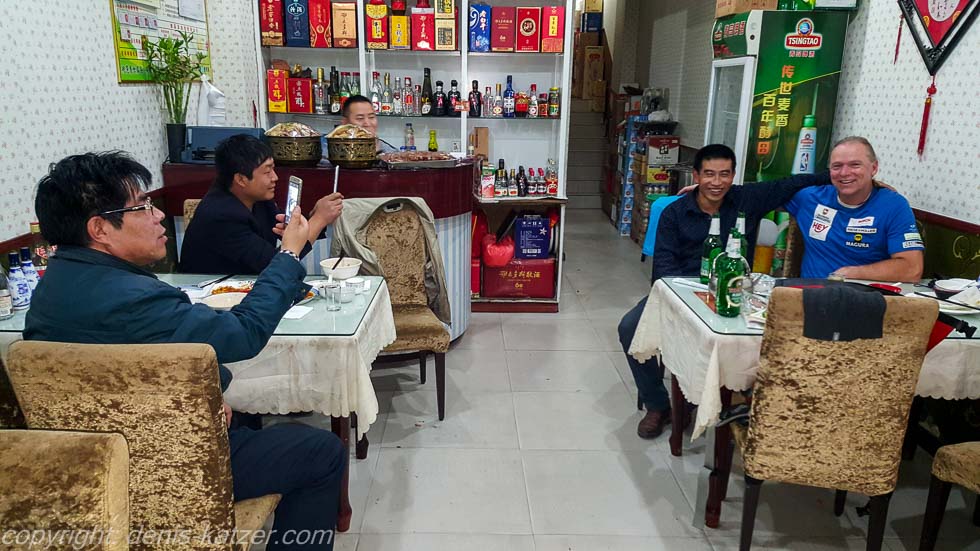
A new dimension of curiosity – Inside the rock caves – Schnapps in exchange for a photo
N 38°51'17.9'' E 110°29'26.2''
Date:
09.11.2015
Day: 134
Country:
China
Province:
Shaanxi
Location:
Shenmu
Latitude N:
38°51’17.9”
Longitude E:
110°29’26.2”
Daily kilometers:
100 km
Total kilometers:
10,557 km
As the crow flies:
54.66 km
Average speed:
22.5 km/h
Maximum speed:
44.1 km
Travel time:
4:26 hrs.
Soil condition:
Asphalt
Maximum height:
1.250 m
Total altitude meters:
7.531 m
Altitude meters for the day:
670 m
Sunrise:
07:12 am
Sunset:
5:31 pm
Temperature day max:
14 °C
Temperature day min:
2 °C
Departure:
10:00 a.m.
Arrival time:
5:00 p.m.
Total plate tires:
8
Plate front tire:
2
Flat rear tire:
5
Plate trailer tire:
1
(Photos of the diary entry can be found at the end of the text).
On our first evening in Baode, we went to one of the many inconspicuous, small roadside restaurants to satisfy our enormous appetite for cyclists. As soon as we entered the room, which was furnished soberly as always, all the guests suddenly stopped eating and looked at us as if we were ghosts. Well, that’s nothing new for us, but we still thought we had encountered a new dimension of curiosity in this city. So far we’ve been able to deal with the sudden superstar level quite well, but that evening after 135 kilometers on the road to hell driven by heavy goods vehicles, we just wanted to have dinner in peace and then fall into bed. The whispering at the neighboring tables got louder and louder. The owner of the restaurant approached our table somewhat cautiously and showed us a photo on his smartphone of two cyclists and a white dog looking at us. This time it was us who were wide-eyed with surprise. “How did our picture get into his camera?” I wondered. “I’ve got it,” said Tanja after a while. “When we drove into town, we stopped next to the post office to ask for directions.” “So what?” “We were photographed there all the time.” “So what?” I asked again because I still didn’t understand. “Well, someone from the Chinese there must be friends or relatives of our host here and immediately sent him the pictures.” “Amazing,” I replied.
At first it was just a guest who had tried to secretly photograph us. To do him a favor, we interrupted our meal and had our picture taken arm in arm with him. Then his friends wanted a similar picture, then the neighboring table, then the owner and finally all the employees. So a quiet, peaceful dinner was out of the question. When we reached our hotel afterwards, the photo session was repeated with some of the staff. The receptionist, every kitchen employee, the security guard and cleaning ladies all wanted to have at least one picture of themselves with foreigners.
As the weather was miserable for the next three days, we decided to sit it out. We spent most of the time in our room. We ate our lunch and dinner undisturbed within the protection of our four walls, which Tanja bought for us in one of the many supermarkets.
Today, the fourth day in the city of Baode, the unpleasant continuous rain has stopped. We spontaneously decide to continue our journey. We cycle past the famous yellow river, the Huang He, for a short while. I would love to take a few pictures of the second longest river in China and the fourth longest single river in the world, but thick fog prevents us from seeing anything. “I would have loved to see if it was really yellow,” I say to Tanja as we stand on a bridge and look down into the murky soup of fog below us. “Do you know how long it is?” asks Tanja. “Some say it’s 4845 kilometers long, others say it’s even 5464 kilometers long.” “Where do the different statements come from?” “Apparently it’s due to the different measurement methods,” I reply thoughtfully. “What’s going through your mind?” Tanja wants to know because I’m obviously forgetting to look at the only vaguely recognizable watercourse. “Hm, I was just thinking about what an adventure it would be to follow this river by kayak from its source in the vast expanses of the highlands of Tibet to its mouth in the Gulf of Bohai, on the edge of the Yellow Sea.” “Now let’s tackle the 12,000 kilometers ahead of us on an e-bike before you start plotting another adventure,” she replies with a laugh.
As soon as we crossed the Huang He, we rolled over another invisible provincial border. We now leave Shanxi behind us and the province of almost the same name, Shaanxi, where 13 dynasties had their residence for over a thousand years, opens its doors to us. Today, 38 million people live in the easternmost province of northwest China. That is 175 inhabitants per km² in an area of 205,800 km². In comparison, 227 people live per km² in Germany. Until the end of the 19th century, the province was still dominated by Muslim ethnic groups such as the Hui, who made up 78% of the population. Then the Muslim uprisings occurred during which millions of people were killed. After that, most of the Muslim communities were destroyed. Today, Muslims make up only 1 percent of the population.
We follow a narrow country road. Because the arterial road winds through small villages, valleys and past mountain ranges, the evil trucks chose the easier S20 highway. Relieved to only be threatened by a few heavily laden trucks today, we enjoy the ride as much as we can, because here, too, a large number of power stations pollute the air.
Again and again, the sun peeps through the thick blanket of fog and eats a veritable hole in the gray wall. By midday, the last wafts of mist have evaporated and we are greeted by a blue sky. “Great!” I cheer, raising my right fist to the sky. For some time now, there have been large signs with brown paint on the side of the road. They point out places of interest. “Does it make sense to drive up there?” I ask, because the direction arrow points to a steep, narrow pass road. “We have enough energy in our batteries,” says Tanja. “That’s right. Then up the mountain,” I reply, which is why we pedal our bikes up the hairpin bends in turbo mode. The newly concreted road leads further and further into the mountains. The remains of old watchtowers from the Great Wall of China stretch their skeletons into the blue sky to our left and right.
After another 300 meters in altitude, deep gorges run alongside us through the yellow loess rock. Our eyes glide over a rugged, impressive mountain landscape. In the distance, on the back of another mountain range, sits a temple. There has been no sign of the annoying road traffic up here for a long time. Small, still original villages appear. The farmers laid their harvest directly on the road to dry. Their eyes widen in surprise as we glide past them almost silently. “Ni hao!” we greet in a friendly manner. Then it continues uphill. “Where is the temple we were told about?” asks Tanja. I answer with a shrug of my shoulders. “Let’s go as far back as there,” I suggest, pointing to a point where the path hides behind a ridge. Suddenly we discover large holes in the yellow loess rock next to us. “Rock caves,” I say and stop.
“Are you going first?” I ask because we don’t both want to leave our bikes alone at the same time. “You go,” Tanja offers me the lead. I walk quietly through a ravine that cannot be seen from the road and unexpectedly find myself in a kind of man-made courtyard. “Wow,” I whisper and climb into the cave that was abandoned not so long ago. Ajaci, who accompanies me, wants to jump into the dark interior first. “Are you crazy?” I hold him back. “Stay behind me, otherwise you’ll fall into some deep hole and I’ll have to get you out in the end,” I whisper, climbing deeper into the caves. It doesn’t take much imagination to believe that the first hominids settled in this region 1.15 million years ago, as Shaanxi is considered one of the most important cradles of Chinese civilization. “Get out of there Ajaci!”, I scold my dog as he runs into a narrow, dark corridor, the end of which I can’t see from my position. Suddenly it trickles from the ceiling. Startled, I look up. Dry loess sand falls onto a bed below, also made of loess. Ajaci and I squeeze through another narrow corridor into an adjoining cave. There are large chunks of earth and rock lying around here that came loose from the ceiling above us not too long ago. I have an uneasy feeling when I think of the largest and most momentous earthquake in Chinese history, which occurred in Shaanxi in 1556 and is estimated to have claimed 830,000 lives. According to the records, over 60% of all inhabitants died in some regions of the province. Back then, most people lived in such yaodongs. Many of their inhabitants were buried alive by the tremors of the quake. “Rrrsssss”, it trickles from the ceiling right in front of us. “Let’s get out of here,” I say to my dog and hurry back outside.
“And is it worth seeing in there?” asks Tanja. “Absolutely. But you have to make sure you don’t fall in anywhere. Some of the caves are also at risk of burglary,” I warn her as she runs off to have a look at some of the yaodongs.
A little later we discover the reason for the sign on the road. It is a brand new, very small Buddhist temple made of concrete. As we have already visited many ancient places of worship worth seeing in our lives, we leave this one unvisited and head back down into the valley. An old farmer’s wife, perhaps 1.40 meters tall, greets us. We stop our bikes. She limps over to Tanja. “Ni shi narr en?” (Where do they come from?) we understand. “Wo lai zi deguo”, (I come from Germany) answers Tanja. The woman shakes her head as if she hasn’t understood Tanja. “Ihaa! Ihaa! Ihaa!”, the plaintive call of a donkey mingles with the rudimentary conversation, as if he too wanted to tell us something about his meagre life up here in the mountains. Standing in front of a still inhabited cliff dwelling, he nibbles at the hay his owner has thrown down. The old woman laughs and asks more questions that we don’t understand. “We have to move on. “Zaiijan!” (Goodbye), we say goodbye. “Hi, hi, hi,” it laughs behind us as we steer our aluminum steeds in sweeping curves around the crops lying on the road. “The world has stood still here,” says Tanja as she drives alongside me for a few meters on the lonely little road. “A beautiful world,” I reply. “Yes, but the people are certainly very poor,” she replies. “It’s not always poor what looks poor, if these people are happy with their lives, they are rich,” I reply. “You’re certainly right,” says Tanja.
After 100 kilometers we drive through the town of Sehnmu. About 30 or 50 meters above us, the city is crossed by a breathtaking freeway construction several kilometers long. “Watch the road!” Tanja admonishes me as I look up in amazement, soon stunned at what man can build.
As soon as we have stowed our bikes and equipment in the lobby of today’s accommodation and parked Ajaci on his blanket in the room, we go to one of the restaurants. This time it’s a more modern restaurant where many young Chinese dine. As soon as we open the door, everyone there falls silent again. Startled, we look into the large room and shout “Ni hao!” out of sheer embarrassment. “Ni hao! Ni hao! Ni hao!” echoed from all directions. We walk past a reception counter where three young women are looking at us open-mouthed. “Ni hao!”, we greet them too and sit down at the only free table. “I think you have to book here,” I say quietly to Tanja, looking at the still puzzled faces of the reception girls. But now they thaw out, laugh and shout loudly into the kitchen. A young waiter immediately comes over and brings the menu. “Phew, thank goodness there are pictures in there,” I say, pointing to the various photographed dishes. The guests slowly get used to our presence and continue to eat. “Gambei!” (cheers) is shouted next to us. A young man hands me a shot glass to clink glasses with me. I politely take the glass, clink it and tip the clear liquid down my throat. “Hooo”, I exclaim, causing everyone at the neighboring table to collapse with laughter. The ice is broken, my throat is lubricated and the first cell phones and smartphones are pulled out. “Gambei”, it shouts. The friend of the first person to pass me a shot glass presses another full glass into my hand. “Gambei!” I shout too, whereupon almost everyone in the entire restaurant turns to look at me. “Do you want to get drunk?” asks Tanja with a grin. “Certainly not,” I reply, but I can already feel the stuff getting into my head after 100 km of cycling. “Gambei!” I hear again. Again, I pour the schnapps down my throat in return for a few photos. “But that’s enough now. I don’t want any more schnapps. I hope others in the restaurant don’t get the idea of drinking the foreigners under the table,” I say, sitting down again. As soon as I’ve settled down, the gambei roars through the restaurant again!” I’m about to jump up to receive my next shot, but this time the next table wants a photo with Tanja. “Ha, ha, ha, just make sure you don’t get drunk,” I snort with delight as Tanja puts her lips to her glass. I’m surprised to see her return the cup just as full as she got it. “You cheated,” I whisper. “I didn’t. You don’t have to finish every glass you get.” “Hm, that’s right. If another one of those cups wanders over, I’ll go for a sip too,” I say and finally get around to looking at the menu…
The live coverage is supported by the companies Gesat GmbH: www.gesat.com and roda computer GmbH www.roda-computer.com The satellite telephone Explorer 300 from Gesat and the rugged notebook Pegasus RP9 from Roda are the pillars of the transmission.
